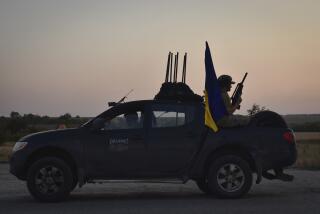Croatian Leader Reopens Key Bridge, Airport : Balkans: Access to the Adriatic Sea is regained despite warnings of Serbian retaliation.
- Share via
MASLENICA, Croatia — President Franjo Tudjman of Croatia reopened a strategic bridge and airport Sunday to the music of a marching band, the distant rumble of artillery and U.N. warnings that the moves could provoke another war.
The pontoon bridge rejoining Croatia’s interior with the Adriatic Sea coast is deemed so economically vital that the Zagreb leadership insisted on opening it despite the risk of sparking fierce retaliation by the heavily armed Serbs who surround the area.
Yet only minutes after the flashy ceremonies amid the combat wreckage around Maslenica bridge and Zemunik airport, both facilities were closed again out of fear for their safety.
The area around Maslenica had been shelled by Serbian rebels only hours before the festivities, prompting a 10-hour postponement and jittery nerves among the dignitaries, military brass and foreign press.
Restoring the key transport links demonstrated the Croatian leadership’s resolve to reclaim land and assets seized by rebel Serbs in an offensive two years ago.
But it also said much about the lengths the leaders of a small Balkan country will go to in one-upping enemies.
Despite warnings that Scud-type missiles were trained on his capital and that the Serbs had made “blood-curdling threats” of retaliation, Tudjman led his Cabinet and thousands of cheering countrymen across the bumpy pontoons into the ghost town of Maslenica.
An even more hazardous inauguration reopened Zemunik airport in the scrubby lowlands west of Maslenica that the 1991 war transformed into a rubble-strewn wasteland. Hundreds of journalists, guests and Tudjman himself flew into the exposed facility.
Two Croatia Airlines jets and Tudjman’s private Canadian-made Challenger swept onto the pocked Zemunik runway as two soldiers, one with binoculars and the other with a rifle, posted what amounted to air traffic control from the shell of the airport tower.
The looted terminal, stripped during its Serbian stewardship of everything from lighting fixtures to stairway treads, had been cleared of shattered glass since Croatian forces recaptured it and the land around Maslenica in a January offensive.
“This is a symbol of the renewed unity of our country, the north and the south,” Tudjman proclaimed from a rostrum set up in the open-air terminal. “It is the first step toward re-establishing the integrity of our state.”
While the bridge and airport were ceremoniously reopened without hostile incident, both seem likely to become targets of Serbian artillery as rebels in the Krajina enclave press their campaign for independence from Croatia.
U.N. officials in Zagreb said that up to 20 artillery rounds fell in the hours before dawn and sporadic mortar fire was reported later.
Both the Croatian government and U.N. officials had feared an attack on the ceremonies to which everyone who is anyone in Croatia was invited. Most Western diplomats, wary of the Serbian rebel resentment, steered clear of the pageantry.
Only a face-saving compromise engineered by the U.N. peacekeeping force here is thought to have averted a deadly and politically humiliating disaster.
After failing to convince Tudjman that he risked aggravating the Serbian rebels by repairing the vital transport links before both sides reached a political agreement, U.N. mediators offered to have the peacekeeping force take over operation of the contested facilities.
The U.N.-brokered agreement signed on behalf of the Croatian government and the self-styled leadership of the Krajina Serbs called for a peaceful reopening of the bridge and airport on condition both be limited to civilian use and that Croatian forces withdraw from the region by July 31.
If the government fails to honor the pullout clause--a move that would be highly unpopular in a country whose economy has been devastated by the disruptions of war--the Serbian forces within range of the pontoon bridge are widely expected to bombard it.
Tudjman had also met in Geneva on Saturday with Serbian President Slobodan Milosevic for talks believed to have included a deal that would allow him the political boost of opening the bridge and airport without serious incident.
Milosevic reportedly agreed to tolerate the gesture. However, his control over the Krajina Serbs is questionable as economic disaster in Serbia has cut into the arms and fuel he can spare for the Serbian fighters in Croatia and Bosnia-Herzegovina.
Since the original Maslenica bridge was bombed by Serbs in November, 1991, traffic between the Croatian mainland and the southern Dalmatian area where 700,000 live has depended on a ferry and rickety island bridges to circumvent Serb-held territory.
Croatian forces recaptured the geographically important, though largely ruined swath of territory including Maslenica, Zemunik and the Peruca Dam in January when they overran a U.N.-patrolled cease-fire line and flushed out the enemy Serbs.
The Krajina Serbs have cut themselves off from the rest of the republic and have refused to allow commerce and transport through the territory until they are granted independence or autonomy.
More to Read
Sign up for Essential California
The most important California stories and recommendations in your inbox every morning.
You may occasionally receive promotional content from the Los Angeles Times.











